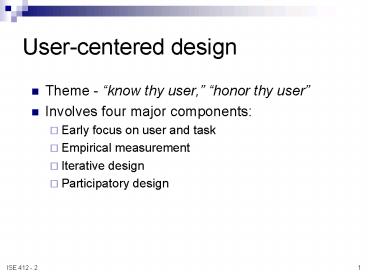Usercentered design - PowerPoint PPT Presentation
Title:
Usercentered design
Description:
Norman, D.A. (1988) The Design of Everyday Things. ... Example: Carter's 1979 study of the effects of various display characteristics ... – PowerPoint PPT presentation
Number of Views:48
Avg rating:3.0/5.0
Title: Usercentered design
1
User-centered design
- Theme - know thy user, honor thy user
- Involves four major components
- Early focus on user and task
- Empirical measurement
- Iterative design
- Participatory design
2
Normans Theory of Action
3
Gulfs of Evaluation and Execution
4
Design to bridge the gulfs
5
To explore further
- Norman, D.A. (2005) Human-Centered Design
Considered Harmful, http//www.jnd.org/dn.mss/
human-centered_desig.html - Norman, D.A. (1988) The Design of Everyday
Things. New York Doubleday (originally published
as The Psychology of Everyday Things. NY Basic
Books.)
6
HUMAN FACTORS RESEARCH
- What can we measure?
- Attitude and motivation
- Preferences
- Knowledge
- Skills and abilities (physical and mental)
- Aptitude and potential to perform/succeed
- Emotion (happy, sad, mad, excited, tense)
- Physiological states
- Behavior
- Performance
7
RESEARCH METHODS IN HUMAN FACTORS ENGINEERING
- Basic vs Applied
- Definitions
8
Dimensions of Research Methodologies
- Tradeoff Experimental Control vs Real-World
Relevance - Degree of Control
- over conditions of observation
- over "treatment" (independent) variables
- Degree to which behavioral (dependent) variables
are representative of some larger population - Will the results "scale up" to complex real-life
situations?
9
Research Methodology In a Nutshell
- Define problem and hypotheses
- What questions do you want to answer?
- What cause/effect relationships do you expect to
see? - Specify the experimental plan
- Independent variables (Treatment)
- Dependent variables (Effect)
- Experimental design
- Specifics
10
Research Methodology In a Nutshell (cont.)
- Conduct the study
- follow the plan you defined
- use a pilot study if you are unsure of your
plan - Analyze the data
- Quantitative/objective data
- Subjective data
- Protocol analyses
11
Research Methodology In a Nutshell (cont.)
- Draw conclusions
- Were the hypotheses supported by the results of
the experiment? - Statistically significant? (Usually use p 0.05
or 0.01, but these are not carved in stone!) - Recall Type I and Type II errors
- If not significant, are there interesting trends
in the data? - Interaction effects? (e.g., mouse vs keyboard
confounded with type of input required when
filling out online forms) - Can you say why?
- Will effect the degree to which you can
generalize your results. - Can you explain interaction effects, trends that
are not statistically significant?
12
An overview of experimental types
- Laboratory Experiment
- Example Carter's 1979 study of the effects of
various display characteristics on search time
using college students in a dark quiet room.
13
An overview of experimental types
- Field Experiment / Quasi-Experiment
- Examples (1) Comparing new ATC interface with
existing using real air traffic controllers in
real-life settings (field experiment).
(2)Comparing "New Math" to conventional
instruction by assigning programs to different
classrooms (quasi-experiment).
14
An overview of experimental types
- Simulation Study
- Examples Flight simulators, power plant control
simulators.
15
An overview of experimental types
- Field Study (Case study)
- Examples (1) flight crew task analyses conducted
in-flight to determine task allocation, workload,
etc. prior to specification and design of
automated systems (2) investigators observation
and modeling of satellite ground operations - Investigator observes and records real-life
activities without any experimental
manipulations. - Typically, such a study seeks to articulate how
and why some behavioral phenomenon occurs. - Generally, should be the first step in
investigating human interaction with complex
systems.
16
Descriptive Methods
- Survey/Questionnaire
- Used to gauge attitudes, preferences, etc., often
on a numerical scale - (e.g., 1strongly disagree, ..., 5strongly
agree). - Amenable to statistical analyses.
- Problems
- how to avoid biased questions
- Respondents may not be totally truthful
17
Descriptive Methods (cont.)
- Interview
- Also used to gauge attitudes, preferences, etc.
- Can delve into the reasons behind those
attitudes. - Can be used with a questionnaire to clarify or
expand on responses. - Problems
- Same as with survey/questionnaire.
- Tricky to analyze.
18
Descriptive Methods
- Concurrent Verbal Protocols
- While the subject performs a task (in a
laboratory, field, or simulation setting), he/she
verbalizes- thoughts, reasons for actions, etc.
This is often very illuminating in terms of
identifying subject strategies, difficulties,
etc. But difficult to analyze and may affect
task performance itself. - Retrospective Verbal Protocols
- After the subject has performed a task (in a
laboratory, field, or simulation setting), he/she
verbalizes thoughts, reasons for actions, etc.
This may also be quite interesting, but again is
difficult to analyze. Also this relies on the
subject's memory, which is prone to error. - Also critical incident technique, accident
analysis.
19
General Remarks
- Before you do any experiment, you should have one
or more hypotheses in mind that you want to test
or explore. - If possible, use multiple methods (e.g., field
study and interviews and questionnaires). - If you obtain converging evidence from a number
of separate sources, you can be more confident
that the hypothesis is correct. - Consider reliability and validity issues
- Reliability
- Construct Validity
20
General Remarks (cont.)
- Reliability and validity issues (concl.)
- Internal Validity (for causal or explanatory
studies) - External Validity
- Ethical Issues
- Ethical treatment of human subjects (see pg. 37
of Wickens et al.) - protection from mental and physical harm
- privacy
- informed consent
- Code of Engineering Ethics































